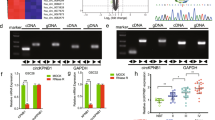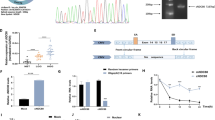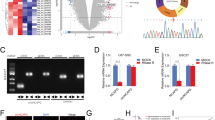Abstract
Objective
Cancer stem cells or cancer stemness has been confirmed to a major obstacle for glioma progression and it has also been reported that circRNAs play an important part in cancer progression. This study mainly focuses on revealing the role of circRPPH1 and the underlying mechanisms in glioma cell stemness.
Methods
In vitro experiment including RT-qPCR, Western blot, sphere-formation analysis, and ALDH1 activity, and in vivo tumorigenesis experiments were performed to evaluate the effects of circRPPH1 on glioma cell stemness. Luciferase reporter, ChIP, and DNA pull-down analysis were used to reveal the underlying mechanisms.
Results
It was found that circRPPH1 level was upregulated in glioma cell spheres and facilitated the stemness of glioma cells; C-FOS transcriptionally activated circRPPH1 expression via directly binding to circRPPH1 promoter in glioma cells. Moreover, circRPPH1 promoted the stemness of glioma cells dependent on c-FOS-mediated transcriptional activation.
Conclusions
This study indicates that c-Fos-activated circRPPH1 contributes to glioma stemness and provides a potential target for glioma progression based on the c-FOS/circRPPH1 regulatory axis.





Similar content being viewed by others
Data availability statement
All data generated or analyzed during this study are included in this published article.
References
Zhu H, Liu D, Cheng L, Liu J, Wang G, Li H, et al. Prognostic value and biological function of galectins in malignant glioma. Front Oncol. 2022;12:834307.
Batlle E, Clevers H. Cancer stem cells revisited. Nat Med. 2017;23(10):1124–34.
Wang J, Quan Y, Lv J, Gong Sh, Dong D, et al. BRD4 promotes glioma cell stemness via enhancing miR-142-5p-mediated activation of Wnt/β-catenin signaling. Environ Toxicol. 2020;35(3):368–76.
Tachon G, Masliantsev K, Rivet P, Desette A, Milin S, Gueret E, et al. MEOX2 transcription factor is involved in survival and adhesion of glioma stem-like cells. Cancers (Basel). 2021;13(23):5943.
Zhang L, Yin Y, Chen H, Feng S, Liu J, Chen L, et al. TRIM24 promotes stemness and invasiveness of glioblastoma cells via activating Sox2 expression. Neuro Oncol. 2020;22(12):1797–808.
Yuan X, Wei W, Bao Q, Chen H, Jin P, Jiang W. Metformin inhibits glioma cells stemness and epithelial–mesenchymal transition via regulating YAP activity. Biomed Pharmacother. 2018;102:263–70.
Muhammad N, Bhattacharya S, Steele R, Phillips N, Ray R. Involvement of c-Fos in the promotion of cancer stem-like cell properties in head and neck squamous cell carcinoma. Clin Cancer Res. 2017;23(12):3120–8.
Jiang P, Li F, Liu Z, Hao S, Gao J, Li S. BTB and CNC homology 1 (Bach1) induces lung cancer stem cell phenotypes by stimulating CD44 expression. Respir Res. 2021;22(1):320.
Lu D, Chen S, Tan X, Li N, Liu C, Li Z, et al. Fra-1 promotes breast cancer chemosensitivity by driving cancer stem cells from dormancy. Cancer Res. 2012;72(14):3451–6.
Konno Y, Dong P, Xiong Y, Suzuki F, Lu J, Cai M, et al. MicroRNA-101 targets EZH2, MCL-1 and FOS to suppress proliferation, invasion and stem cell-like phenotype of aggressive endometrial cancer cells. Oncotarget. 2014;5(15):6049–62.
Zhu Y, Zheng B, Luo G, Ma X, Lu X, Lin X, et al. Circular RNAs negatively regulate cancer stem cells by physically binding FMRP against CCAR1 complex in hepatocellular carcinoma. Theranostics. 2019;9(12):3526–40.
Tao T, Yuan S, Liu J, Shi D, Peng M, Li C, et al. Cancer stem cell-specific expression profiles reveal emerging bladder cancer biomarkers and identify circRNA_103809 as an important regulator in bladder cancer. Aging (Albany NY). 2020;12(4):3354–70.
Jiang Y, Zhou J, Zhao J, Zhang H, Li L, Li H, et al. The U2AF2 /circRNA ARF1/miR-342-3p/ISL2 feedback loop regulates angiogenesis in glioma stem cells. J Exp Clin Cancer Res. 2020;39(1):182.
Gu Y, Wang Y, He L, Zhang J, Zhu X, Liu N, et al. Circular RNA circIPO11 drives self-renewal of liver cancer initiating cells via Hedgehog signaling. Mol Cancer. 2021;20(1):132.
Lin X, Chen W, Wei F, Xie X. TV-circRGPD6 nanoparticle suppresses breast cancer stem cell-mediated metastasis via the miR-26b/YAF2 axis. Mol Ther. 2021;29(1):244–62.
Zhao C, Li L, Li Z, Xu J, Yang Q, Shi P, et al. A novel circular RNA hsa_circRPPH1_015 exerts an oncogenic role in breast cancer by impairing miRNA-326-mediated ELK1 inhibition. Front Oncol. 2020;10:906.
Huang Y, Zheng W, Ji C, Wang X, Yu Y, Deng X, et al. Circular RNA circRPPH1 promotes breast cancer progression via circRPPH1-miR-512-5p-STAT1 axis. Cell Death Discov. 2021;7(1):376.
Xiong J, Song S, Xiong L, Duan C, Song Q, Yu D, et al. CircRPPH1 promotes cell proliferation, migration and invasion of non-small cell lung cancer via the PI3K/AKT and JAK2/STAT3 signalling axes. J Biochem. 2022;171(2):245–52.
Xu J, Zhang G, Hu J, Li H, Zhao J, Zong S, et al. UPF1/circRPPH1/ATF3 feedback loop promotes the malignant phenotype and stemness of GSCs. Cell Death Dis. 2022;13(7):645.
Liu J, Yang H, Deng J, Jiang R, Meng E, Wu H, et al. CircRPPH1 promotes the stemness of gastric cancer cells by targeting miR-375/SLC7A11 axis. Environ Toxicol. 2022. https://doi.org/10.1002/tox.23668.
Ni H, Qin H, Sun C, Liu Y, Ruan G, Guo Q, et al. MiR-375 reduces the stemness of gastric cancer cells through triggering ferroptosis. Stem Cell Res Ther. 2021;12(1):325.
Hu Y, Smyth G. ELDA: extreme limiting dilution analysis for comparing depleted and enriched populations in stem cell and other assays. J Immunol Methods. 2009;347(1–2):70–8.
Yang Y, Li X, Wang T, Guo Q, Xi T, Zheng L. Emerging agents that target signaling pathways in cancer stem cells. J Hematol Oncol. 2020;13(1):60.
Joo J, Schaukowitch K, Farbiak L, Kilaru G, Kim T. Stimulus-specific combinatorial functionality of neuronal c-fos enhancers. Nat Neurosci. 2016;19(1):75–83.
Tanaka S, Ishii T, Sato F, Toi M, Itou J. Eribulin mesylate-induced c-Fos upregulation enhances cell survival in breast cancer cell lines. Biochem Biophys Res Commun. 2020;526(1):154–7.
Yang L, Liu Z, Ma J, Wang H, Gao D, Zhang C, et al. CircRPPH1 serves as a sponge for miR-296–5p to enhance progression of breast cancer by regulating FOXP4 expression. Am J Transl Res. 2021;13(7):7556–73.
Li J. Y Li and H Cheng, Circ-RPPH1 knockdown retards breast cancer progression via miR-328-3p-mediated suppression of HMGA2. Clin Breast Cancer. 2022;22(3):e286–95.
Zhou Y, Liu X, Lan J, Wan Y, Zhu X. Circular RNA circRPPH1 promotes triple-negative breast cancer progression via the miR-556-5p/YAP1 axis. Am J Transl Res. 2020;12(10):6220–34.
Shi D, Shi X, Xing K, Zhou H, Lu L, Wu W. miR-296-5p suppresses stem cell potency of hepatocellular carcinoma cells via regulating Brg1/Sall4 axis. Cell Signal. 2020;72:109650.
Li Z, Wu X, Li J, Yu S, Ke X, Yan T, et al. HMGA2-Snai2 axis regulates tumorigenicity and stemness of head and neck squamous cell carcinoma. Exp Cell Res. 2022;418(1):113271.
Zheng L, Xiang C, Li X, Guo Q, Gao L, Ni H, et al. STARD13-correlated ceRNA network-directed inhibition on YAP/TAZ activity suppresses stemness of breast cancer via co-regulating Hippo and Rho-GTPase/F-actin signaling. J Hematol Oncol. 2018;11(1):72.
Acknowledgements
Not applicable.
Funding
Not applicable.
Author information
Authors and Affiliations
Contributions
GX designed the research. GX, JQ, MZ, and QW performed the research. GX and JQ wrote the manuscript. MZ re-reviewed the manuscript.
Corresponding author
Ethics declarations
Conflict of interest
The authors declare no conflict of interest.
Ethics approval
All the experiments were obtained the approval of the Ethics Committee for Animal Experimentation of the Second Affiliated Hospital of Xi'an Jiaotong University.
Consent to publication
Not applicable.
Additional information
Publisher's Note
Springer Nature remains neutral with regard to jurisdictional claims in published maps and institutional affiliations.
Rights and permissions
Springer Nature or its licensor (e.g. a society or other partner) holds exclusive rights to this article under a publishing agreement with the author(s) or other rightsholder(s); author self-archiving of the accepted manuscript version of this article is solely governed by the terms of such publishing agreement and applicable law.
About this article
Cite this article
Xu, G., Qu, J., Zhang, M. et al. C-Fos-activated circRPPH1 contributes to glioma stemness. Clin Transl Oncol 25, 1277–1286 (2023). https://doi.org/10.1007/s12094-022-03022-3
Received:
Accepted:
Published:
Issue Date:
DOI: https://doi.org/10.1007/s12094-022-03022-3




